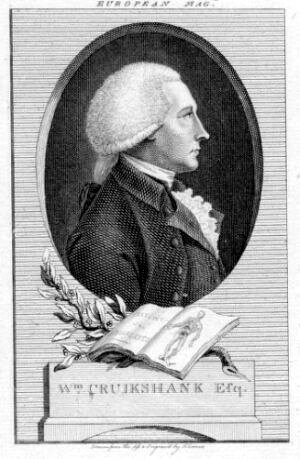William Cruickshank (chemist) facts for kids
Quick facts for kids
William Cruickshank
|
|
|---|---|
 |
|
| Born | circa 1740 |
| Died | circa 1811 |
| Citizenship | Scottish |
| Alma mater | Royal College of Surgeons of England King's College, Aberdeen |
| Known for | characterization of carbon monoxide |
| Scientific career | |
| Fields | Chemistry |
| Institutions | Royal Military Academy, Woolwich |
William Cruickshank was a Scottish scientist who lived a long time ago. He was a military surgeon, a chemist, and a professor. He taught chemistry at the Royal Military Academy, Woolwich.
He earned a special diploma in 1780 from the Royal College of Surgeons of England. Later, in 1788, he became an assistant to another scientist, Adair Crawford. In 1802, he was chosen to be a Fellow of the Royal Society, which is a big honor for scientists.
Contents
Amazing Discoveries and Inventions
William Cruickshank made several important discoveries in chemistry. He helped us understand more about different substances.
Understanding Carbon Monoxide
In 1800, Cruickshank figured out what carbon monoxide was made of. He showed that it was a compound containing both carbon and oxygen. This was a big step in understanding gases.
Cleaning Water with Chlorine
Also in 1800, he found a new way to clean water. He used chlorine to purify it, making it safer to drink. This method is still used today! He also discovered the chloralkali process, which is used to make chlorine and other chemicals.
The Mystery of Strontium
Some people believe Cruickshank was the first to suspect a new element. He found it in a mineral called strontianite from Scotland. This mineral made flames turn a reddish color. Another scientist, Adair Crawford, is also credited with this discovery. Later, Humphry Davy was able to get the pure element, which we now call strontium.
Researching Diabetes
Cruickshank worked with a doctor named John Rollo in the 1790s. They studied diabetes, a condition where the body has trouble with sugar. Some of Cruickshank's findings were published in Rollo's book. During this research, he also managed to isolate urea in 1798.
Inventing the Trough Battery
Around 1800, Cruickshank created a better type of battery. It was called the Trough battery. It was an improvement on Alessandro Volta's earlier battery, the voltaic pile. In Cruickshank's design, the battery plates lay flat in a trough. This made it easier to use and more stable.
Experiments with Electrolysis
After hearing about Volta's battery, Cruickshank started doing his own experiments. He explored electrolysis, which uses electricity to separate substances. He put wires from a battery into different solutions.
For example, when he put wires into solutions of lead acetate, copper sulfate, or silver nitrate, something amazing happened. Pure lead, copper, or silver appeared on one of the wires! He realized that electricity could pull pure metals out of solutions. This process is now called electrowinning. It is very important for refining metals like copper.
Later Life and Retirement
In March 1803, William Cruickshank became very sick. It's thought that this might have been from working with dangerous chemicals. One possibility is exposure to phosgene gas during his experiments.
He retired on July 6, 1804, and received a small pension. He passed away in 1810 or 1811. Military records show that he died in Scotland.
See also

